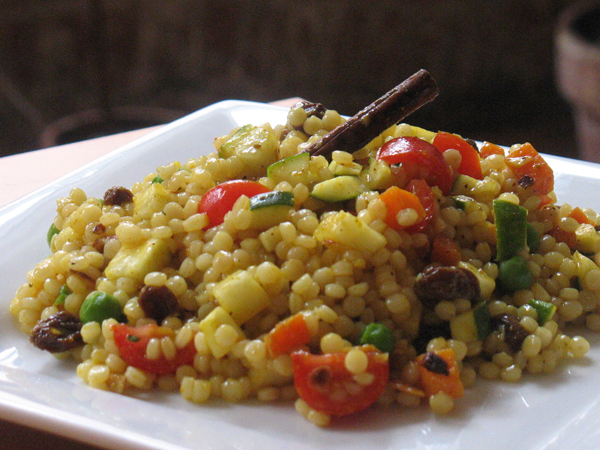 Combining local foods with the realities of your pantry
Combining local foods with the realities of your pantry
recipes by Dynise Balcavage
Like many people who are concerned about the environment, I dutifully seek out locally-grown produce. I try to patronize restaurants that lean heavily on local fare. I even make my own soy and coconut ice creams instead of purchasing my favorite West Coast-produced brand.
But at the same time, I love to travel and try exotic new foods from different cultures. For gourmands like me, permanently abstaining from Belgian dark chocolate, Israeli couscous and Jamaican curry powder is just not in my realm of reality.
Happily, like most things in life, eating locally is not a black and white issue. Any step you can take toward helping the environment is a lean, green step to be applauded. Using one local ingredient is better than using none. Eating one vegan or vegetarian meal a week is better for Mama Earth—not to mention for your health and, of course, the animals—than a steady diet of Quarter Pounders with cheese. That’s why, in this month’s column, I wanted to show you that you can seamlessly mix and match local ingredients with the realities of your pantry. Like every other learned behavior, making green choices in the kitchen gets easier and more fun with practice.
Blood Orange Cupcakes with Easy Dark Chocolate Ganache
[serves 6]
I fell in love with blood oranges in Spain, where I enjoyed them freshly juiced at every breakfast. Their sanguine hue makes them appear somewhat foreboding, but, in actuality, their easygoing flavor makes them the kinder, gentler citrus. These cupcakes are impossibly light while the ganache is hedonistically decadent. Enjoy them with a sip of Cointreau —or a cup of orange spice tea. This recipe makes six cupcakes, but it is easily doubled.
Cupcakes:
- 3 tbsp. canola oil
- 1/2 cup soy or rice milk
- 1 cup blood orange juice (juice of about 2 to 3 oranges)
- 1/2 tsp. vinegar
- 1/2 cup sugar
- 3/4 cup flour (Daisy Organic Flour, made in Lancaster County, available at the Fair Food Farm Stand at the Reading Terminal Market)
- 1/2 tsp. baking powder
- dash of salt
Ganache:
- 1/4 cup dark chocolate buttons or chips (70 percent cocoa, minimum)
- 2 tbsp. vegan margarine (non-hydrogenated)
- 1/4 tsp. orange extract
- 1/4 tsp. vanilla extract
- blood orange wedges for garnish
Directions:
For the Cupcakes:
- Preheat oven to 325 degrees. Place liners in cupcake pans. In a medium bowl, mix wet ingredients, including zest, until smooth.
- In a large bowl, mix dry ingredients. Stir in the wet ingredients and mix until very smooth. There should be no lumps.
- Fill pans ¾ full with batter. Bake 20 to 25 minutes, or until knife inserted in center of cupcakes comes out clean.
- Let cool completely on a rack before icing with ganache.
For the Ganache:
- Mix all ingredients in a medium glass bowl. Microwave on 50 percent power until melted. (Times will vary depending on your microwave.) Or melt in a small saucepan on the stove over low heat.
- Stir well and allow to cool slightly. Spread ganache on top of cupcakes. Adorn each cupcake with an orange section or some orange zest.
- Allow ganache to harden slightly before serving.
 Jamaican Curried Couscous Salad
Jamaican Curried Couscous Salad
[serves 8]
Many people think couscous is a grain, but it’s really a petite pasta. Typically used in Middle Eastern dishes, couscous greedily absorbs whatever flavors you feed it. In this case, the flavor of choice is Caribbean curry powder. Caribbean curry’s mild sweetness highlights the dish’s other subtly sweet ingredients, like raisins, carrots and agave nectar.
For this salad, I prefer using Israeli couscous: The pellets are bigger, rounder, a bit chewier, and the curry powder and turmeric paint them a stunning saffron hue.
This dish travels well and can be served warm, room temperature or chilled. It’s the perfect dish to bring to summer picnics along with your favorite reggae CDs.
Ingredients:
- 1/4 cup slivered almonds
- 2 1/2 tbsp. extra-virgin olive oil
- 2 tsp. Carribean curry powder (Do not use Indian or Thai curry; the results will not be the same)
- 1/2 tsp turmeric
- 1 dash ground cinnamon
- 1 garlic clove, minced
- 1 tbsp. water
- 1 tbsp. agave nectar
- 1 cinnamon stick
- 1 medium carrot, finely diced
- 1/2 cup unsulphured raisins or sultanas
- 1/2 cup frozen peas, or fresh peas, shelled
- 3/4 cups Israeli or pearl couscous
- 1 small zucchini, finely diced
- 10 cherry or grape tomatoes, quartered
- salt and pepper
Directions:
- In a small bowl, whisk together olive oil, curry powder, turmeric, dash of cinnamon, garlic, water and agave nectar.
- Heat a small skillet to medium high. Toast almonds, turning frequently, until golden brown, about five minutes. Remove from heat and set aside.
- Bring a large saucepan full of water to a boil. When boiling, add cinnamon stick, carrots, raisins, frozen peas, 1/2 tsp. salt and couscous. (If using fresh peas, add them about 3-4 minutes before the couscous is completely cooked.) Boil for 10 minutes, or until couscous is al dente. The couscous may absorb much of the water; this is normal.
- Drain couscous-vegetable mixture and rinse with cool water to stop it from cooking.
- In a large bowl, gently toss couscous-vegetable mixture with dressing, tomatoes, zucchini and toasted almonds. Salt and pepper to taste.
Dynise Balcavage, author of urbanvegan.net, lives and writes in Philadelphia. Her cookbook, The UrbanVegan: 250 Simple, Sumptuous Recipes From Street Cart Favorites to Haute Cuisine is available for pre-order on Amazon.com and will hit bookstores this fall. She’s been featured in The New York Times, The International Herald Tribune and VegNews.


